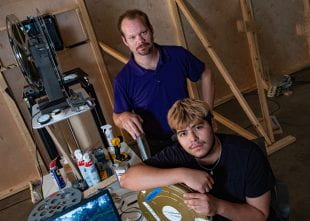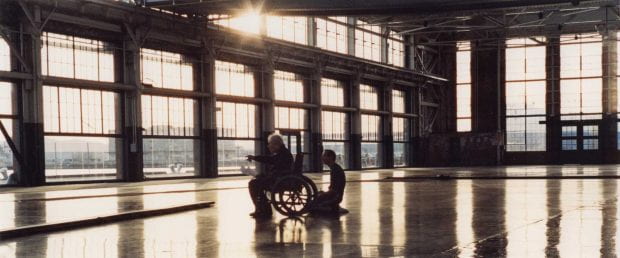Tacita Dean’s film ‘Craneway Event’ demanded much more than a rare 16 mm projector
Rob Blumrick has suspended 1,400-pound glass-and-metal chandeliers from the ceiling of the Brown Foundation Gallery inside the Moody Center for the Arts. He’s helped transform its black box theater space into a 1920s-era Berlin streetscape for a Dada-inspired dance performance. He’s overseen the installation of six seamlessly joined projection screens that displayed pixel-sized particles governed by chaos theory movement patterns.

Rob Blumrick and Wiess College junior Agustin Carrizales Jr. in the projection booth at the Moody Center. (Photo by Jeff Fitlow)
But the latest installation Blumrick has overseen at the Moody has been by far the most challenging.
With mere weeks to change over from Michel Blazy’s “We Were the Robots” exhibition in the Brown Foundation Gallery — a piece that covered the two-story walls with blue algae and piled six tons of charcoal onto the concrete floor — Blumrick and his crew cleared it all out and built an entirely movie theater from scratch. (Check out the time lapse video of the process below.)
They also had to track down a 16 mm movie projector capable of holding feature-length reels of film, a piece of equipment so rare only a few are still believed to be in existence.
Now, when a visitor enters the gallery, the sensation of walking into a movie theater is seamless. That’s just how Blumrick envisioned it — and nothing less would do for the film being screened there three times daily through July 13.
“Craneway Event” is a 16 mm film portrait of a legendary dancer created by the equally legendary living artist Tacita Dean. Presented as a tribute to what would be Merce Cunningham’s 100th birthday this year, Dean’s film runs nearly two hours. On screen, Cunningham’s dance company rehearses a repertoire of his pieces in an abandoned Ford assembly plant in Richmond, California, as Cunningham looks on from his wheelchair.
Dean, hailed as the “great poet of art film,” made “Craneway Event” in 2008. Cunningham died while she was still in the process of editing it. Elegiac, lit with warm afternoon sun like a Dutch Golden Age painting, quiet and contemplative, it is a film that demands a suitably respectful space.

A still from Tacita Dean’s “Craneway Event,” on view through July 13 at Moody Center. (16 mm colour anamorphic film, optical sound)
Blumrick has served as the Moody’s production manager since it opened in 2017. Acting as a middleman between the art and the space where it will be installed, Blumrick’s background in theater tech is evident in the execution of new exhibits the Moody brings into its three galleries.
For “Craneway Event,” Blumrick’s theater background led him to prefabricate wooden wall panels so he and his crew of student workers could quickly move those pieces into the Brown Foundation Gallery once it was empty. They also figured out the dimensions that would allow the gallery to show Dean’s film in its anamorphic aspect ratio. The installation took “almost the entirety of last semester to plan,” Blumrick said, not to mention the time spent tracking down one critical piece of equipment: a very specific kind of 16 mm projector designed for theatrical use.
“It is still a favorite medium for many artists,” Blumrick said of the film format, which was originally introduced in 1923 for amateur enthusiasts. “But it’s also a technology that I was not that familiar with.”
In fact, he’d seen a 16 mm projector only once his life, and that was a long time ago. Way back in 1989, when he worked as production manager at the Glema Mahr Center for the Arts in Madisonville, Kentucky, somebody bought two of the projectors but never even bothered unpacking them. Nobody ever used them.
Blumrick found a 16 mm projector for sale in South Carolina with the help of Tish Stringer, a lecturer and the film program manager in Rice’s Department of Visual and Dramatic Arts (VADA).
“I reached out to Tish very early on to ask what something like this was going to entail,” Blumrick said. “She was like, ‘Whose film is this?’ I sent her the specs and she said, ‘This is Tacita Dean? And this is going to be your first 16 mm setup?’” Blumrick laughed. “Yeah, only the Tacita Dean, only the premier 16 mm filmmaker in the world.”
As the film flickers across the screen Blumrick and his team built from scratch, the projector whirrs gently in the background. It’s hidden in a spacious projectionist booth manned by Rice students Agustin Carrizales Jr., Carlos Tafur and Connor Ayubi working rotating shifts.
“I took a photography class with Geoff Winningham at the Media Center, so I had to learn how to develop film,” said Carrizales, a Wiess College junior double-majoring in VADA and mathematical economic analysis who also helped install the temporary movie theater. “But I’d never worked with 16 mm film before this.”
Blumrick enjoys the opportunities to collaborate with faculty such as Stringer and to mentor students such as Carrizales, making each installation a true group effort. And then there’s the chance to work with with artists such as Dean, who approved the Moody’s installation herself when she visited this month for the opening of “Craneway Event” — hard-won praise from an artist who is rightfully particular about the spaces in which her films are shown.
“Before I came here, the type of stuff that I was doing was Brad Paisley or Darius Rucker concerts, pop acts and Broadway stuff, high school productions, community theater — not art,” Blumrick said. “This is all art. It is a totally different world than what I came from, and it’s been a lot of fun.”

